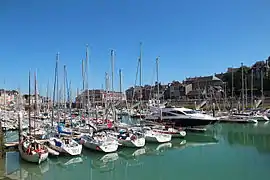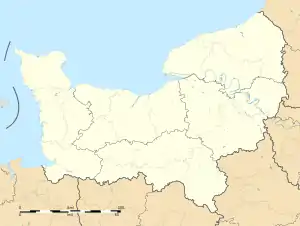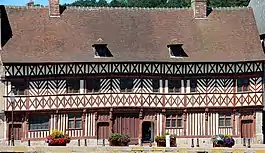Saint-Valery-en-Caux
Saint-Valery-en-Caux (French pronunciation: [sɛ̃.valʁi.ɑ̃.ko:]) is a commune in the Seine-Maritime department in the Normandy region in northern France.
Saint-Valery-en-Caux | |
|---|---|
 The marina and town centre | |
.svg.png.webp) Coat of arms | |
Location of Saint-Valery-en-Caux 
| |
 Saint-Valery-en-Caux  Saint-Valery-en-Caux | |
| Coordinates: 49°51′40″N 0°42′36″E | |
| Country | France |
| Region | Normandy |
| Department | Seine-Maritime |
| Arrondissement | Dieppe |
| Canton | Saint-Valery-en-Caux |
| Intercommunality | CC Côte d'Albâtre |
| Government | |
| • Mayor (2014–2020) | Dominique Chauvel |
| Area 1 | 10.47 km2 (4.04 sq mi) |
| Population (2017-01-01)[1] | 4,006 |
| • Density | 380/km2 (990/sq mi) |
| Time zone | UTC+01:00 (CET) |
| • Summer (DST) | UTC+02:00 (CEST) |
| INSEE/Postal code | 76655 /76460 |
| Elevation | 0–80 m (0–262 ft) (avg. 5 m or 16 ft) |
| 1 French Land Register data, which excludes lakes, ponds, glaciers > 1 km2 (0.386 sq mi or 247 acres) and river estuaries. | |
The addition of an acute accent on the "e" (Valéry) is incorrect.
Geography
A small fishing port and light industrial town situated in the Pays de Caux, some 20 miles (32 km) west of Dieppe at the junction of the D53, D20, D79 and the D925 roads. Here, huge chalk cliffs rise up from the pebble beach (sandy at low tide) to overlook the English Channel. The SNCF station closed in the 1990s and the only public transport available is an infrequent bus service.


History
It is said to have been founded by Saint Valery in the 7th century. A monastery was built on the site of the present-day town and was known as ‘’’Sanctum Walaricum’’’ in 990 CE, according to the charter in which Richard I, Duke of Normandy, gave the town (part of his personal property) to the abbey of Fecamp. A busy fishing port from the 13th to the 17th century, its decline was due to the growth of the much larger port of Fecamp, to the west.
It is perhaps best known as the place where the British 51st (Highland) Infantry Division commanded by Major-General Victor Fortune and French troops surrendered to Major-General Erwin Rommel on June 12, 1940, with the town partly destroyed in the fighting. Saint-Valéry-en-Caux was liberated on 11 September 1944 by a re-formed 51st Highland division,[2] among scenes of great local jubilation.[3] On 17 January 1945, the railway station was destroyed when a runaway train full of American troops crashed into it. Eighty-nine American soldiers were killed and 152 were injured.[4]
The town has a casino, waterpark and has achieved the highest rating of four flowers in the annual France in Bloom competition. Tourism now accounts for much of the town's prosperity.
Heraldry
.svg.png.webp) Arms of Saint-Valery-en-Caux |
The arms of Saint-Valery-en-Caux are blazoned : Azure, 2 dolphins addorsed argent. |
Population
| Year | 1962 | 1968 | 1975 | 1982 | 1990 | 1999 | 2006 |
|---|---|---|---|---|---|---|---|
| Population | 2905 | 3089 | 3274 | 5501 | 4595 | 4782 | 4733 |
| From the year 1962 on: No double counting—residents of multiple communes (e.g. students and military personnel) are counted only once. | |||||||
Places of interest
- The church of St. Valery, dating from the fifteenth century.
- A Norman-style half-timber house .
- The Commonwealth War Graves Commission cemetery.
- A seventeenth-century cloister from the old convent.
- The lighthouse.
- The memorial to the 51st Highland Division, on the cliff tops.
People
- French artist Adrien Victor Auger (1787–1854), was born here in October 1787.
- Orientalist Charles Defrémery (1822–1883) died in Saint-Valery-en-Caux.
- Chelsea Football Club footballer Demba Ba grew up here.
References
- "Populations légales 2017". INSEE. Retrieved 6 January 2020.
- Armées.com - Ossian Seipel's Memoirs ch 7
- Trevor Royale. Queen's Own Highlanders: A Concise History. pp. 163, 187. Mainstream Publishing Ltd. Edinburgh. 2007. ISBN 9781845960926.
- Russell C. Eustice Recalls the Troop Train 2980 Tragedy at St. Valery-en-Caux During World War II
External links
| Wikimedia Commons has media related to Saint-Valery-en-Caux. |
- Official website of Saint-Valéry-en-Caux (in French and English)
- Unofficial Website of the commune (in French)
- The City of Inverness - twinning with St Valéry
- Website of Aeroclub Cauchois (LFOS) Discover Normandy from the air (in French)
- The CWGC cemetery
- History of the shipowner's house 'Henry IV house' including surprising links with Cannibals and South America!